AMD Radeon HD 7790 Review Feat. Sapphire: The First Desktop Sea Islands
by Ryan Smith on March 22, 2013 12:01 AM EST- Posted in
- GPUs
- AMD
- Sapphire
- GCN
- Radeon HD 7000
Compute Performance
As always we'll start with our DirectCompute game example, Civilization V, which uses DirectCompute to decompress textures on the fly. Civ V includes a sub-benchmark that exclusively tests the speed of their texture decompression algorithm by repeatedly decompressing the textures required for one of the game’s leader scenes. While DirectCompute is used in many games, this is one of the only games with a benchmark that can isolate the use of DirectCompute and its resulting performance.
Our next benchmark is LuxMark2.0, the official benchmark of SmallLuxGPU 2.0. SmallLuxGPU is an OpenCL accelerated ray tracer that is part of the larger LuxRender suite. Ray tracing has become a stronghold for GPUs in recent years as ray tracing maps well to GPU pipelines, allowing artists to render scenes much more quickly than with CPUs alone.

Our 3rd benchmark set comes from CLBenchmark 1.1. CLBenchmark contains a number of subtests; we’re focusing on the most practical of them, the computer vision test and the fluid simulation test. The former being a useful proxy for computer imaging tasks where systems are required to parse images and identify features (e.g. humans), while fluid simulations are common in professional graphics work and games alike.

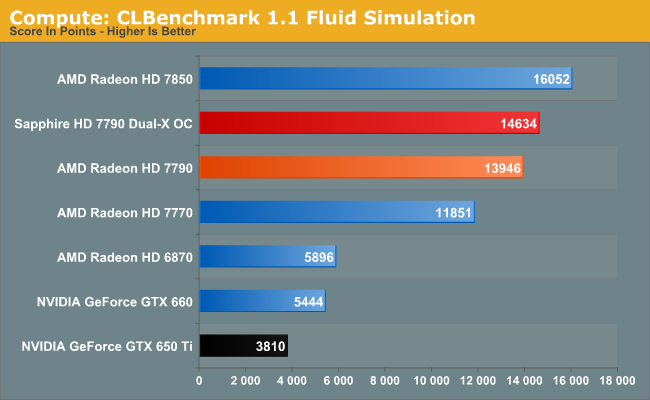
Moving on, our 4th compute benchmark is FAHBench, the official Folding @ Home benchmark. Folding @ Home is the popular Stanford-backed research and distributed computing initiative that has work distributed to millions of volunteer computers over the internet, each of which is responsible for a tiny slice of a protein folding simulation. FAHBench can test both single precision and double precision floating point performance, with single precision being the most useful metric for most consumer cards due to their low double precision performance. Each precision has two modes, explicit and implicit, the difference being whether water atoms are included in the simulation, which adds quite a bit of work and overhead. This is another OpenCL test, as Folding @ Home is moving exclusively OpenCL this year with FAHCore 17.
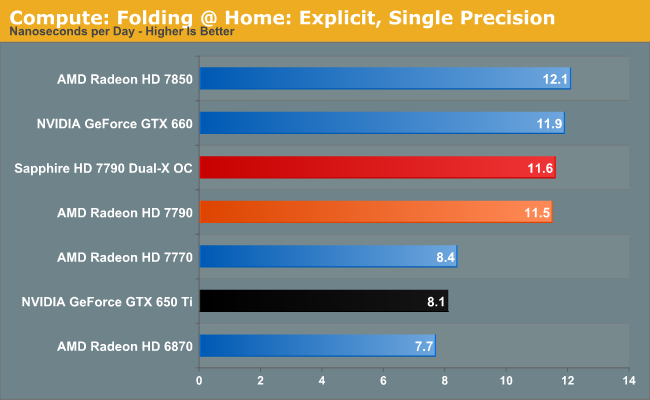
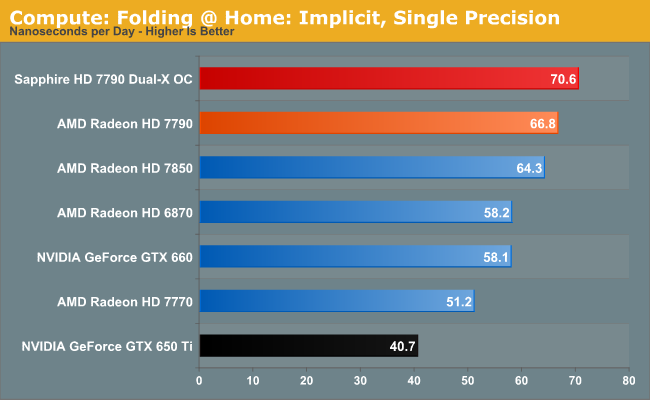
Our 5th compute benchmark is Sony Vegas Pro 12, an OpenGL and OpenCL video editing and authoring package. Vegas can use GPUs in a few different ways, the primary uses being to accelerate the video effects and compositing process itself, and in the video encoding step. With video encoding being increasingly offloaded to dedicated DSPs these days we’re focusing on the editing and compositing process, rendering to a low CPU overhead format (XDCAM EX). This specific test comes from Sony, and measures how long it takes to render a video.
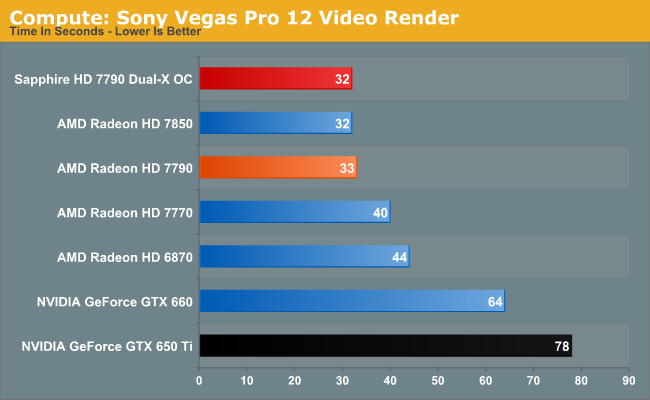
Wrapping things up, our final compute benchmark is an in-house project developed by our very own Dr. Ian Cutress. SystemCompute is our first C++ AMP benchmark, utilizing Microsoft’s simple C++ extensions to allow the easy use of GPU computing in C++ programs. SystemCompute in turn is a collection of benchmarks for several different fundamental compute algorithms, as described in this previous article, with the final score represented in points. DirectCompute is the compute backend for C++ AMP on Windows, so this forms our other DirectCompute test.
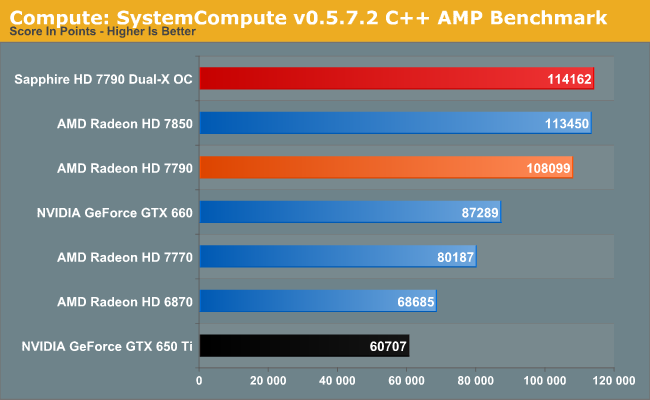


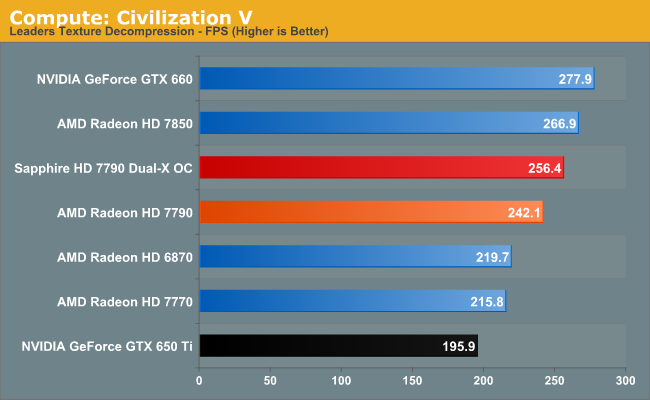








107 Comments
View All Comments
Sabresiberian - Monday, March 25, 2013 - link
A roadmap is nothing but a projection of what is PLANNED for the future, not some kind of "promise" or "guarantee". Calling AMD people liars because the released product didn't match the projection is childish at best.And before you slap the "fanboy" label on me, I prefer Nvidia generally speaking (but I'm not going to cut off my proverbial nose to spite my face in order to be brand loyal; if AMD has the current best solution for my purposes, I'm going to buy AMD).
CeriseCogburn - Saturday, March 23, 2013 - link
128 bit bus is great, the HD5770 proved that.BWHAHAHHAAA
dishayu - Friday, March 22, 2013 - link
Good eye. But then they metion HD7790 as Pitcairn LE in that infographic. What they have launched as HD7790 now is Bonaire.ShieTar - Friday, March 22, 2013 - link
Maybe they surprised themselves by getting GDDR5 to run at 6GHz, and realized that they can stick with 128bit at that speed?Lonyo - Friday, March 22, 2013 - link
They were going to use a cutdown Pitcairn, being 7870/7850 GPU, and cut down the GPU core to use excess cores that couldn't make the cut as 7870/7850s.They might have gone with 256-bit to simplify the product for AIB partners who could just re-use their HD7850 designs, rather than needing a new design for a smaller run product.
The 7790 now is a new GPU designed to be cheaper to produce (as it's smaller) than Pitcairn, and the fact the memory can run at 6GHz is probably due in part to the fact it's a new GPU rather than a cut down Pitcairn.
CeriseCogburn - Friday, March 22, 2013 - link
I don't see a launch date in the whole article, it's NOT available. I guess that's another mystery freebie for AMD's products here.Didn't see port config either, so what cabling do we have to buy to run 3 monitors when Asus 650ti runs 4 out of the box, 3 with dvi and vga only ?
Not impressed with the huge AMD biased game line up either, so expect your mileage to be less than shown.
No overclock talk really either - so it must blow at that.
Other sites are reporting amd's beta driver, so maybe they won't even have a release driver for this card when they release it, as AMD is often known to do, for like a year sometimes or forever in terms of any sort of quality-LOL.
Civ5 has only 1 bench rez, it must have crashed in others.
Crossfire ? Article didn't say.
Multi-monitor - no talk of that anymore since nVidia SPANKS amd to death on that now.
Hopefully you've fooled the internet tards again, because amd is bankrupt, for good reason.
Spoelie - Friday, March 22, 2013 - link
Let's feed the troll.Did you even read the article?
-Launch date is mentioned on page 1, in one and a half week
-Ports are clearly visible and standard, 2 DVI + HDMI + DisplayPort
-Lineup is consistent with every other review on Anandtech.
-There's an entire page on the new PowerTune and how it impacts overclocking, single sample OC investigation is irrelevant and best left for a dedicated vendor comparison.
-... really?
Who's the real tard here?
Spunjji - Friday, March 22, 2013 - link
Oh for a down-vote button. We expect no less than mindless bollocks from Cerise, but failing to read the article entirely is a new low.CeriseCogburn - Saturday, March 23, 2013 - link
No, that's what you do all the time. But thanks for the compliment, since you know I always read the articles completely, yet you think I didn't this time, WRONG.I've made a lot of money this past short week without a lot of rest, so I'll give you and dipsy doodle a point on the svengali launch date the article writer for the first time EVER declares "solid" before it even occurs, og wait, he always does that when it's AMD, but if it's nVidia he says we'll have to wait and see as they are probably lying...
ROFL
Who cares, the card sucks, amd is dying, the drivers blow beta chunks, and amd is way late to the party.
ppeterka - Thursday, July 18, 2013 - link
Just a question: And how much will your favored brand of GPUs cost, if AMD really dies? 10 times? 100 times? An arm, a leg, and both kidneys? Grow up, and understand how an ecosystem works for us all.BTW. I don't have GPU preferences, just grab what gives bets bang for bucks. If it has EasternElbonianVideoPigs GPU on it - be it...